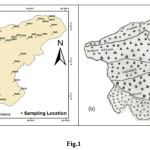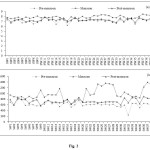Seasonal Variation in Ph and Alkalinity of Groundwaters in Sidhi District, Central India
Asmaa Naaz1 * and Anshumali 1
Corresponding author Email: asmaa.dhn@gmail.com
DOI: http://dx.doi.org/10.12944/CWE.10.3.34
A study of pH and alkalinity in thirty-nine groundwater locations in the semi-arid region of Central India was carried out with the objective of monitoring and controlling the groundwater pollution seasonally. The study area was Sidhi district bounded by Son river in North, Gopad river in the east, Banas river in the west and Kusmi forest in the south. Geologically, the entire Sidhi district is dissected into Vindhyan, Archean, Dharwar and Permian regions. The study revealed higher alkalinity in the area ranging beyond the standard permissible limit while pH of all locations was well within the permissible limits (8.5). Increased pH and alkalinity were reported in the monsoon. The prevailing hydrochemical processes are water-rock interaction, seepage, percolation and leaching in the Sidhi district.
Copy the following to cite this article:
Naaz A, Anshumali. Seasonal Variation in Ph and Alkalinity of Groundwaters in Sidhi District, Central India. Curr World Environ 2015;10(3) DOI:http://dx.doi.org/10.12944/CWE.10.3.34
Copy the following to cite this URL:
Naaz A, Anshumali. Seasonal Variation in Ph and Alkalinity of Groundwaters in Sidhi District, Central India. Curr World Environ 2015;10(3). Available from: http://www.cwejournal.org/?p=12939
Download article (pdf) Citation Manager Publish History
Select type of program for download
| Endnote EndNote format (Mac & Win) | |
| Reference Manager Ris format (Win only) | |
| Procite Ris format (Win only) | |
| Medlars Format | |
| RefWorks Format RefWorks format (Mac & Win) | |
| BibTex Format BibTex format (Mac & Win) |
Article Publishing History
| Received: | 2015-06-30 |
|---|---|
| Accepted: | 2015-09-29 |
Introduction
Groundwater is the most esteemed wealth of nature for sustenance of life on earth and any developmental activity. Despite being a common commodity, water is scarce on the earth and has no substitute. As per Kumar et al., 2005 retrieval of safe drinking water is imperative, as 30 % of urban and 90% of rural Indian population depends utterly on untreated groundwater resources. Understanding of the hydrogeochemical processes and pollutant source and regular monitoring of water quality are essential for sustainable development and effective management of groundwater resources of any region.
The pH and alkalinity play an important role in managing groundwater resource. By measuring pH and alkalinity, the character of the sample could be quickly ascertained and related to the geochemistry of the strata. Values of pH beyond the range of 5.0-10.0 indicate industrial pollution and disastrous event. Long-term database on alkalinity values provides researchers with the ability to detect trends in the chemical makeup of waters (Voluntary Estuary Monitoring Manual, 2006). Weathering of carbonates adds alkalinity to the water bodies and raises the pH (Sengupta, 2014). Kupwade and Langade (2013) reported excess alkalinity reacts with cations resulting in precipitates, which can damage the pipes, valves, etc.
The pH is a negative log of hydrogen ion concentration which indicates whether a substance will behave as an acid or a base and alkalinity maintains a fairly stable pH by neutralizing acids. pH of 7.0 probably represents a neutral system, with greater pH being alkaline and decreased being acid.
pH = -log10 [H+]
Alkalinity = [HCO3-] +2[CO32-] + [OH-] - [H+]
At a pH of approximately 4.3 and below only free mineral acidity (FMA) and dissolved carbon dioxide (H2CO3) is present, and no alkalinity is observed. As the pH is increased between 4.3 and 8.3, the dissolved carbon dioxide converts to bicarbonate ion. On increasing the pH beyond 8.3, the bicarbonate ion is converted to carbonate ion. Conversion is nearly complete at a pH around 10.2 with almost all the bicarbonate being converted to carbonate. Further increasing the pH beyond 10.2, measurable levels of hydroxide ions along with the carbonate ions are noticeable (McDonald, 2006). The groundwater quality in any area is a function of its physical and chemical parameters which in turn are highly influenced by geological formations, climatic conditions, and anthropogenic activities (Matthess, 1982; Subramani et al., 2005). Groundwater chemistry varies depending on duration of contact of groundwater with a particular rock. The longer the duration of contact, the greater is the effect of rock chemistry on the formulation and pH of the groundwater. The chemical formulation of the bedrock tends to buffer the pH of the groundwater. Groundwater passing through carbonate-rich rocks (e.g. limestones and marbles) usually has pH values more than 7. American Ground Water Trust (2003) reported that the acidic nature of the groundwater persist if the geology of the aquifer has few carbonate rocks (e.g., sandstones, metamorphic granitic schists and gneisses; volcanic rocks, etc.) the ground water will tend to remain acidic. Hence, the purpose of the study was to figure out the seasonal variation in pH and alkalinity of groundwater in semi-arid regions around Central India.
Materials and Methods
Study Area
The Sidhi District is situated on the North-eastern boundary of the Madhya Pradesh State, India which lies over a transitional area between the Indo-Gangetic plain in the north and the Deccan plateau in the south. It is situated between 22ÌŠ 47.5' and 24ÌŠ 42.10' North latitude and 81ÌŠ 18.40' and 82ÌŠ 48.30' East latitude (Fig. 1). The total land covered in the Sidhi district is 10,536 km2 in which the forest area covers 40 %. The total population of the area is 11, 26,515 spread with a density of 110/km2 (Census, 2011).
 |
|
Geology
The study region (Sidhi district) in Central India is a part of the Vindhyan-Mahakoshal basin, one of the largest Proterozoic basins in India (Auden, 1933; Tondon et al., 1991), is an important geological domain experience semiarid climate. This zone is marked by linear ridges and low mounds of heterolithic breccias include highly fertile Neoarchean to Palaeoproterozoic basement-cum-provenance (Chhotanagpur Granitic Gneissic Complex), presence of phyllites/carbon phyllites, episodic mafic and acid magmatism and basement reactivation (Banerjee et al., 2010). Topographically the district can be dissected into three zones, Vindhyan hills or Kaimour range, Gondwana zone, and Archean zone. Roy and Bandyopadhyay, 1990 reported the oldest rock units of Tonalite-Trondjhemite series of Sidhi district formed during proto-continental stage (3.7-2.9 Ga) characterizing the age-old concretion.
Field sampling and laboratory analysis
To understand the role of pH and alkalinity in assessing the groundwater quality, 39 groundwater samples were collected from hand pumps in such a way that they represent different geological formations and land use patterns at irregular domain of the Sidhi District in the pre-monsoon (June- 2013) monsoon (August- 2013) and post-monsoon (January- 2014). The report on the age of hand pumps were collected from the dwellers and the range varied from less than one year to twenty years, with an average of seven years. Thity-nine groundwater samples were collected in pure polypropylene bottles without any air bubbles in all the three seasons, respectively. Groundwater samples were filtered through 0.45 µm Millipore filter paper. pH was monitored using electromeric method and alkalinity was determined by titrimetric method as per APHA (2012). Analysis was carried out in duplicates to quantify the error. An overall precision was obtained below 5 % for the entire samples.
Results and Discussion
In the present study pH and alkalinity have shown similar spatial and seasonal variations. The pH of ground water varied from 6.2-7.8, 7.1-8.5, and 6.8-7.9 in the pre-monsoon, monsoon and post-monsoon (Fig. 2a) indicating alkaline pH in the monsoon while acidic to alkaline pH in the pre-monsoon and post-monsoon. The pH values were recorded within the standard permissible limit of 6.5-8.5 (IS: 10500). The Total alkalinity of groundwater locations of Sidhi district ranged from 236-798, 624-1388 and 568-894 mg/l (Fig. 2b) in the pre-monsoon, monsoon and post-monsoon, respectively and were above the recommended permissible limit of 600 mg/l. Greater pH and alkalinity were recorded in monsoon season and showed a positive correlation with one another.
 |
Figure 2: Map showing seasonal variation of (a) pH (b) alkalinity of the Sidhi district Click here to View figure |
Water during monsoon season percolates through the bicarbonate, carbonate, calcite and fluorite rich rocks and leach out into the groundwater from nearby rocks leading to enhanced alkalinity (Raju et al., 2014, Naaz and Anshumali, 2015). Groundwater from limestone aquifer is likely to have high hardness and alkalinity due to the dissolution of bicarbonates and carbonates (Chris, 2010). The high alkalinity may be due to the presence of limestone in the rocky strata as a result of which certain minerals or salts dissolve in water and impart alkalinity (Kumar, 2005). Lithology is the main source of cations, such as Ca2+, Mg2+, Na+ and K+ (Hem, 1991). The weathering of the country rocks and the dissolution of feldspar (plagioclase and potassium varieties) and ferromagnesian minerals (garnet, biotite, sillimanite and pyroxenes) in carbonic acid (H2CO3) contribute to the cations. Among anions, the ion HCO3– is from a lithological source, which is caused by the interaction of CO2 with the water present in the soil zone. The CO2 also releases into the soil zone due to the decay of organic matter and root respiration. Following major geochemical reactions control the groundwater alkalinity:
Cation-silicates (s) + H2CO3 (aq) ⇒ H4SiO4 (aq) + HCO3– (aq) + Ca2+ (aq) + Mg2+ (aq) +
Na+ (aq) + K+ (aq) + clays (s) (3)
CO2 (g) + H2O (l) ⇒ H2CO3 (aq) (4)
H2CO3 (aq) ⇒ H+ (aq) + HCO3– (aq) (5)
Conclusions
Higher values of pH were recorded in monsoon and post-monsoon while lower value of pH was recorded in summer. The groundwater quality of the study area has a principal issue of high alkalinity. The high alkalinity in the monsoon and post-monsoon seasons were mainly due to the weathering of carbonate minerals (limestone and dolostone) present in the country rock. Water during monsoon percolates through the soil profile and rocky strata results into enrichment of dissolved solids and contributed temporary and permanent hardness in the subsurface water. In nutshell, groundwaters supply need treatment before consumption in the Sidhi district.
Acknowledgment
The authors are pleased to Ministry of Human Resource Development, Government of India and Indian School of Mines, Dhanbad for funding the Ph.D. thesis of Ms. Asmaa Naaz (Registration no. 2013DR0060). We are also thankful to the Department of Environmental Science and Engineering Dhanbad for providing the logistic support to carry out field monitoring and laboratory analysis.
References
- Kumar A., Fundamentals of Limnology S.B Nangia for APH Publishing Corporation, New Delhi, (2005).
- Voluntary Estuary Monitoring Manual, A Methods Manual, Second Edition, EPA-842-B-06-003 (2006)
- Sengupta D., Recent Trends in Modeling of Environmental Contaminants by (2014)
- Kupwade R.V and Langade A.D., International Journal of Chem Tech Research 5(5): 2291-2294(2013)
- McDonald J., Alkalinity and pH relationships, CSTN, May (2006).
- Matthess G., John Wiley & Sons, New York, 406 (1982).
- Subramani, T., Elango, L., & Damodarasamy, S. R., Environmental Geology, 47(8), 1099-1110 (2005).
- American Ground Water Trust: the American well owner 3, (2003)
- Census of India. Provisional population totals. Ministry of home affairs. Government of India (2011).
- Auden J.B., Vindhyan sedimentation in Son Valley. Mem. Geol. Surv. India 62(2):141-250 (1933).
- Tondon S.K, Pant C.C, Casshyap S.M., Sedimentary basins of India - Tectonic context. Gyanodaya Prakashan (1991).
- Banerjee R, Agarwal M, Mathanwar S.R, Roy M.K, Maithani P.B, Chaki A., Gondwana Geological Magazine 12:1-18 (2010).
- Roy A, Bandyopadhyay B.K., Cleavage development in Mahakoshal Group of rocks of leemanabad-Sihora area, Jabalpur District, Madhya Pradesh. Indian Miner 44(2-3):111-128(1990).
- APHA, Standard methods for the examination of water and waste water, 22nd edn. American Public Health Association, Washington, DC. (2012).
- Indian standard: Drinking water- IS 10500 : (2012).
- Raju P.A.R. K., Reddy M.S.R., Raghuram P., Suri Babu G., Rambabu T. and Jeevan Kumar J. International Journal of Fisheries and Aquatic Studies; 1(6): 121-127 (2014).
- Naaz A. and Anshumali., Arabian Journal of Geosciences; DOI 10.1007/s12517-015-1936-y (2015).
- Freiser H and Fernando Q., Ionic Equilibria in Analytical chemistry. New York: Wiley, (1963).
- Chris P.W., Original 2010. Review, Water Quality Notes: Alkalinity and Hardness. (2013).







